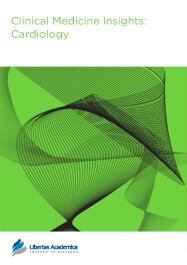

Publication Date: 21 Feb 2012
Type: Original Research
Journal: Clinical Medicine Insights: Cardiology
Citation: Clinical Medicine Insights: Cardiology 2012:6 57-64
doi: 10.4137/CMC.S8602

Background: Balloon valvuloplasty was established as an alternative to surgery for treatment of aortic valve stenosis in childhood. Acute complications after balloon dilatation including aortic insufficiency or early death were described.
Aim of Work: To analyze early outcome and midterm results of balloon aortic valvuloplasty (BAV) in Children’s Hospital, Mansoura University, Egypt.
Subjects and Methods: Between April 2005–June 2008, all consecutive patients of age <8 years treated for aortic valve stenosis (AVS) with BAV were analyzed retrospectively. The study included 21 patients; 17 males, and 4 females. Their age ranged from the neonatal period to 10 years (mean age 5.6 ± 3.7 years). Patients with gradient ≥50 mmHg and aortic valve insufficiency (AI) up to grade I were included. All patients had isolated aortic valve stenosis except 3 patients (14.3%) had associated aortic coarctation. Six patients (28.6%) had bicuspid aortic valve. All patients had normal myocardial function except one (4.8%) had FS 15%. The duration of follow up was (mean ± SD: 18.5 ± 11.7 months).
Results: Femoral artery approach was used in 20 patients (95.2%) and carotid artery in one neonate (4.8%). Balloon/annulus ratio was 0.83 ± 0.04. Significant reduction in pressure gradient was achieved (mean 66.7 ± 9.8 mmHg to 20.65 ± 2.99 mmHg) (P <0.001). Nine patients (42.8%) developed grade I AI, 2 patients (9.5%) developed grade II AI and 1 patient (4.8%) developed grade III AI. Two early deaths (9.5%); one died due to heart failure caused by grade IV AI and a neonate died because of severely compromised LV function. One patient (4.8%) had femoral artery occlusion necessitating anticoagulation. Patients remained free from re-intervention during follow up.
Conclusion: Balloon valvuloplasty of aortic valve stenosis significantly reduces gradient with low morbidity and mortality in children.
PDF (528.16 KB PDF FORMAT)
RIS citation (ENDNOTE, REFERENCE MANAGER, PROCITE, REFWORKS)
BibTex citation (BIBDESK, LATEX)
XML
PMC HTML

I am impressed by the efficiency at each step of submission in the journal. Based on the first-hand experience, I am confident that this journal will have a great future, and the impact factor will rise rapidly.

All authors are surveyed after their articles are published. Authors are asked to rate their experience in a variety of areas, and their responses help us to monitor our performance. Presented here are their responses in some key areas. No 'poor' or 'very poor' responses were received; these are represented in the 'other' category.See Our Results
Copyright © 2013 Libertas Academica Ltd (except open access articles and accompanying metadata and supplementary files.)
Facebook Google+ Twitter
Pinterest Tumblr YouTube